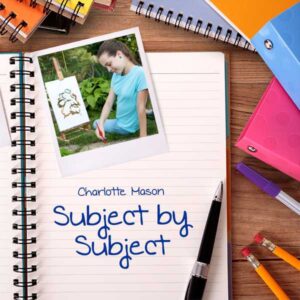Free shipping on USA orders over $129!

It seems that many schools either sprinkle a little art into the curriculum here and there as an afterthought or ignore it all together because of time constraints. Neither approach reflects the goal of a generous curriculum.
Charlotte Mason approached art in a balanced way, regularly scheduling time for her students to both appreciate others’ art and to express their own art. We can do the same regardless of our own artistic capabilities.
Art Appreciation
Art appreciation is accomplished through a method called picture study. Just ten or fifteen minutes once a week is all it takes. Here’s how you do a picture study.
- Select one artist and linger with him or her for twelve weeks.
- Once a week, select one of that artist’s works. Look at it together until everyone can close their eyes and see every detail in its place.
- Hide the picture from view and have the children describe what it looks like.
- Look at the picture again and discuss any other points of interest.
- Display the picture in your home for the rest of the week.
The next week look at a different picture by the same artist. Continue doing a picture study once a week until you have looked closely at six or eight pictures by one artist. You can also read a living biography about the artist, and be sure to grab your Book of Centuries and enter the artist on the appropriate page.
At the end of twelve weeks, you and your students will have a pretty good feel for that artist’s style and ideas communicated through his works. Then choose a different artist and go again.
Charlotte’s desire was to introduce to the child the great ideas of the great artists, presented in their work, and to get out of the way. Hers was not a course in art criticism or art interpretation. She encouraged the children to look closely at each work and to form their own relations with it.
Our award-winning Picture Study Portfolios make art appreciation easy to do and keep everything you need for picture study right at your fingertips.
Art Expression
Charlotte also gave her students instruction in art and opportunities to express themselves artistically. She allowed time for both drawing from the imagination and for reproducing what was seen in life around them with a variety of art media: clay sculpting, charcoal, painting, and drawing.
While there isn’t a lot of detailed description as to how Charlotte taught art instruction, many of the principles that she used for handicrafts would apply.
- Schedule art instruction in the afternoon to allow more time for it after the shorter morning lessons are done.
- Emphasize the habit of best effort.
- To encourage the students to do their best work, teach them slowly and carefully what they are to do.
- Keep the project within reach of their skills. Challenge but don’t frustrate.
- Select projects that are worthwhile. Don’t give them assignments that will just be thrown away, but something that requires their time and effort and will evoke a sense of satisfaction and accomplishment when completed.
Our favorite resource for art instruction is the Creating a Masterpiece videos. You and your students will learn many different medium types from a master artist as you work on projects of varying skill levels. The emphasis is on slow, careful work in an encouraging atmosphere for all ages.
Art is a wonderful way to add variety into your day and to nourish your child’s mind and heart with what is good, noble, and beautiful. With Charlotte’s simple methods and all of the wonderful resources available, you don’t have to be an art expert to give your children the gift of art.
Podcast: Play in new window | Download

I love your picture study portfolios. Is there a set for year 1, etc.? What do you recommend starting with, and each artist is for a term (12 weeks)?
We recommend starting with any artist who appeals most to you! There’s no wrong choice. Each artist should be studied for a full 12-week term. If you want a pre-selected group of artists, check out the Enrichment plans on our free curriculum guide.